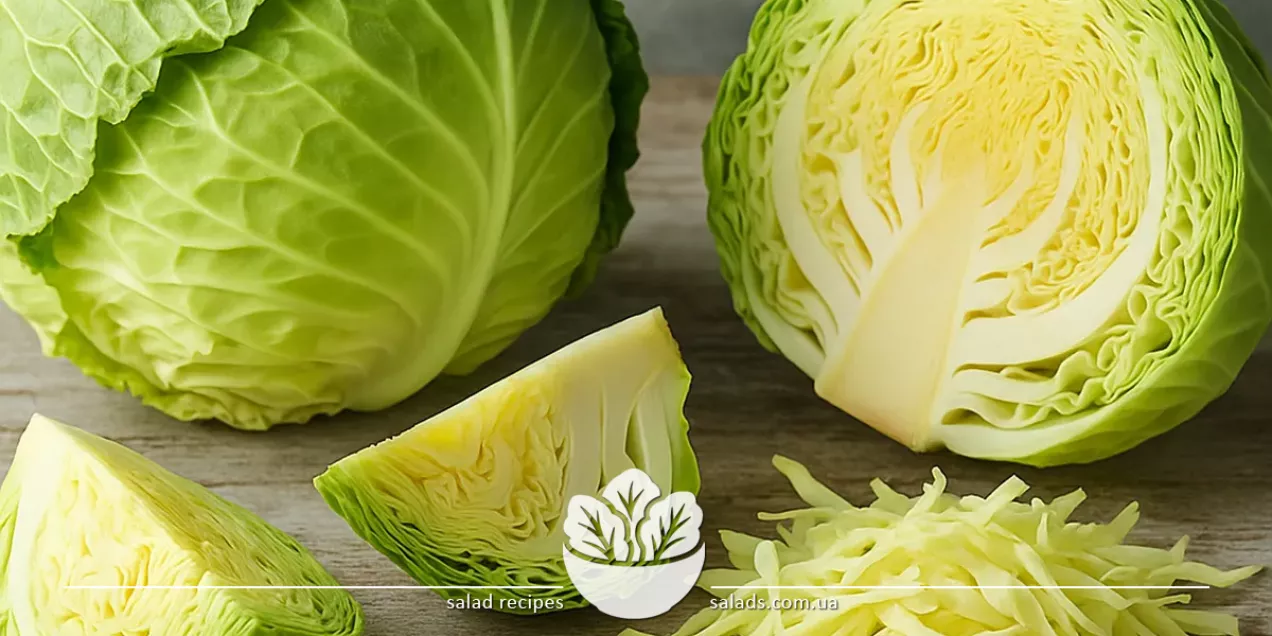
White Cabbage

White cabbage is one of the most common vegetables in Ukrainian cooking, known for its tender taste, juiciness, and versatility. It is used in soups, borscht, cabbage rolls, vegetable stews, pies, and salads, and is also ideal for making sauerkraut. Thanks to its high content of vitamin C, fiber, and minerals, white cabbage is both nutritious and healthy. It can be consumed fresh or cooked. You can explore other types of cabbage in this section.
Salad Recipes with White Cabbage
Flavor, Texture, and Culinary Benefits of White Cabbage
White cabbage has a soft texture and mild flavor that pairs well with many ingredients. When fresh, it is juicy, crunchy, and easily digestible. When cooked, it becomes tender while retaining its structure. These properties make it suitable for a wide range of dishes – from light salads to hearty soups. In raw form, it is often shredded for salads with carrots, onions, greens, or apples. In this case, it adds freshness, crunch, and lightness. When braised, cabbage absorbs the aromas of other ingredients and spices, becoming soft and flavorful. In soups – especially in classic borscht – it serves as a structural element, adding volume and subtly enhancing the taste of the broth. In braised dishes, white cabbage is often paired with yellow onions, which help bring out the vegetable’s natural sweetness. Together, these ingredients form the base for traditional vegetable and meat dishes such as stews, cabbage rolls, borscht, or pies.
White Cabbage in Hot Dishes
Thermal processing allows white cabbage to shine in both simple and complex recipes. The most common methods include braising, baking, and boiling in soups. When braised, cabbage becomes soft but retains structure – especially if lightly sautéed beforehand. It easily absorbs spices, tomatoes, and meat juices, becoming especially aromatic. Cabbage is frequently added to soups – primarily borscht, cabbage soup, or vegetable soups. In these dishes, it adds volume, enhances nutrition, and complements other flavors. In braised meals, it is often combined with carrots, potatoes, greens, and meats – especially pork, which pairs well with the natural sweetness of cooked cabbage. A traditional combination of cabbage and meat is also found in cabbage rolls. After blanching, the cabbage leaves become flexible and suitable for wrapping fillings of rice, minced meat, or vegetables. In this form, the vegetable serves not only as an ingredient but also as an edible wrapper that adds a delicate flavor and helps retain moisture inside.
Salads and Appetizers with White Cabbage
Fresh white cabbage serves as the base for many salads and appetizers. The simplest and most popular version includes shredded cabbage with salt, pepper, lemon juice or vinegar, oil, and herbs. This type of salad pairs perfectly with main dishes, is easy to prepare, and has a pleasant crunch. To diversify the flavor and texture, other vegetables are often added: carrots, beets, bell peppers, or apples. These ingredients bring vibrant color, sweet-sour notes, and extra texture. For a more filling salad, you can add seeds, nuts, or even fried onions. These salads store well and work for both everyday meals and festive occasions. More complex appetizers might include cabbage leaf rolls with cheese or vegetable fillings, cabbage pancakes, or canapés with sauerkraut. Thanks to its neutral and balanced flavor, cabbage blends easily with other ingredients, enhancing rather than overpowering the overall composition.
Combining White Cabbage with Potatoes and Other Vegetables
White cabbage pairs beautifully with other vegetables, especially potatoes, forming the basis of many everyday, hearty dishes. In the simplest version, it is served as a side dish with boiled or fried potatoes – along with fried onions, herbs, or sauce. This is one of the most common combinations in home cooking. Both vegetables are also often prepared together in stews, soups, or casseroles. Potatoes add softness, while cabbage brings volume and a mild sweetness, especially when slightly caramelized. This duo can be enriched with carrots, mushrooms, tomatoes, or beans, creating a deep flavor profile even without meat. Vegetable casseroles with cabbage and potatoes can serve not only as sides but as complete meals. They are convenient to prepare in advance, store well, and can be served hot or cold. These dishes are particularly delicious with the addition of cream, cheese, spices, and garlic – all of which complement the gentle flavor of braised cabbage.
Preserving White Cabbage: Fermenting, Salting, Pickling
White cabbage is one of the most commonly used vegetables for winter preserves. Its natural juiciness, dense structure, and ability to ferment make it ideal for fermenting and salting. This process not only extends shelf life but also enriches the product with beneficial elements – probiotics, vitamins, and enzymes. Classic sauerkraut is made through fermentation in its own juice with added salt, and sometimes carrots, cranberries, or spices. It can be eaten on its own, in salads, or as an ingredient in hot dishes. Thanks to its high vitamin C content, sauerkraut is especially valued in winter as a natural immune booster. Pickled cabbage is another popular method, prepared with vinegar, sugar, oil, and spices. This version has a more pronounced taste, stores longer, and pairs well with meat and vegetable dishes. Regardless of the method, white cabbage remains a key ingredient for delicious and healthy winter preserves.
